Scratch Single Jet S4R Transport Original Design / Scratch Built
Scratch - Single Jet S4R Transport {Scratch}
Contributed by Matt Gillard
| Manufacturer: | Scratch |
Brief:
With the extension to the deadline for the 2009 design this spaceship competition, I thought I'd have a go at another
one of the spaceships, this time I went for the simplest of the six. It was a very rushed build.
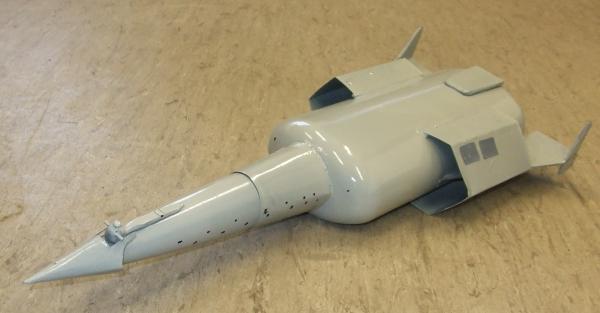
Construction:
The main body of the rocket had to come from a bottle and after a trawl through cupboards at home, I opted for a
talcum powder bottle. Other items used were
- 1x launch lug,
- 1x parachute, 15 inch rip stop nylon- hand made
- 1x 3 foot length of 6 mm knicker elastic
- Snap swivels (optional)
- Engine hook
- Kevlar® ® thread
- Body tube BT55, 10.5 inches
- nose cone
- Motor mount and centering ring –EH -2055
- To build the rocket I used
- Bostik glue
- White glue
- Sanding sealer
- Model knife
- Razor saw
- Aluminium oxide sand paper
The first thing I did was to find nose cones from by spares box that matched the profile of the rocket the best. In the end chose a nose cone to fit a BT55 tube. This was because the tube matched the neck of the talc bottle the best and had the correct dimensions.
Motor Mount Assembly
This was from an old Estes EH –2055 kit. The coupler was discarded, and then the kit was built in the normal fashion. A 2 foot length of Kevlar® card was attached to the motor mount assembly.
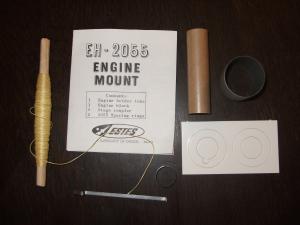
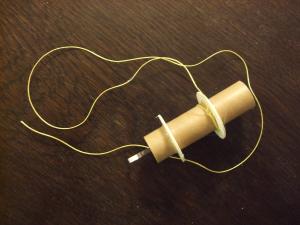
Body Tube Fuselage
The talc bottle had its top cut off, and neck sanded down to the size that snugly fitted a BT 55 tube of 10.5 inches. The bottom of the bottle had a hole cut out using a soldering iron to take the rear of the BT55. The motor mount was glued into the body tube, the body tube was then sanded to remove the gasoline finish and then the body tube was glued into the bottle, leaving 2.6 inches of the body tube sticking out of the talc bottle. Fillets of white glue were added. A shroud of card was then added to give the correct profile.
Nose Cone Assembly
25g of clay was added to the nose cone to aid stability. Detailing was added by using card to make the nose cone front, and plasticine was used to make the other detailing, which were then glued into place.
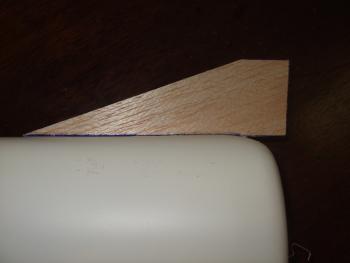 Fin Assembly
Fin Assembly
I'm not of fan of gluing different materials together, and balsa to smooth plastic was going to present the weakest joint in the rocket. To counter this I went for a through the wall design. Side slits were made in the plastic bottle using the soldering iron. The fins were then cut, and then glued into place. Two fillets of white glue were added to give a strong joint.
Side fins were then cut and added, again fillets of white glue were added.
The two side tunnels were made out of balsa, sealed and glued into place using triangle cut balsa to add strength to the join to the plastic talc bottle.
Recovery Assembly
One sheet of reusable Nomex® wadding were attached to the Kevlar® ® cord and then the cord was attached to 3 foot of knicker elastic. The knicker elastic was then attached to the nose cone. A swivel was then added to the elastic shock cord one foot from the nose cone. At the same time that I was making this rocket, I was also making some rip stop nylon parachutes from some military grade parachute material, tin eyelet and Kevlar® thread, these were for a bigger project, but I thought I'd make a “nice” parachute for this rocket. In the end, I went for a 15 inch parachute.
Detailing
Running out of time, the detailing added was minimal.
Finishing:
The rocket was primed and then spray-painted window grey.
Line marking were added with pen.
Had no time to add a clear coat
Flight:
Flight and Recovery.
Before prepping for flight I did a swing test to check for stability, every thing okay.
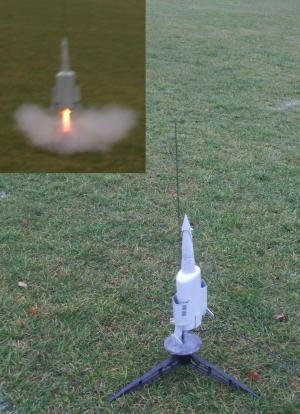 First flight:
First flight:
The parachute was packed.
Wind conditions were still with the occasional breeze.
A standard Estes 3mm rod was used.
An B6-2 was used.
The flight was straight and true, but underpowered and low
Ejection was at apogee, parachute deployed and the rocket landed without damage
Flight two:
Now with a C6-3, flight was much higher than before, and straight. Ejection at apogee, no damage
Flight three:
Again with a C6-3, flight was as before until apogee. Then the nose cone failed to pop off, the rocket came in hard and fast. Not bothering to repair – retired.
Summary:
I'm not overly impressed with this rocket. I rushed the build and was not happy with the finish, on the plus side, I
did like the through the wall fins
 |
 |